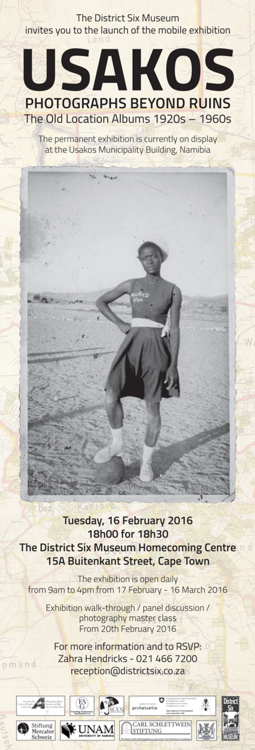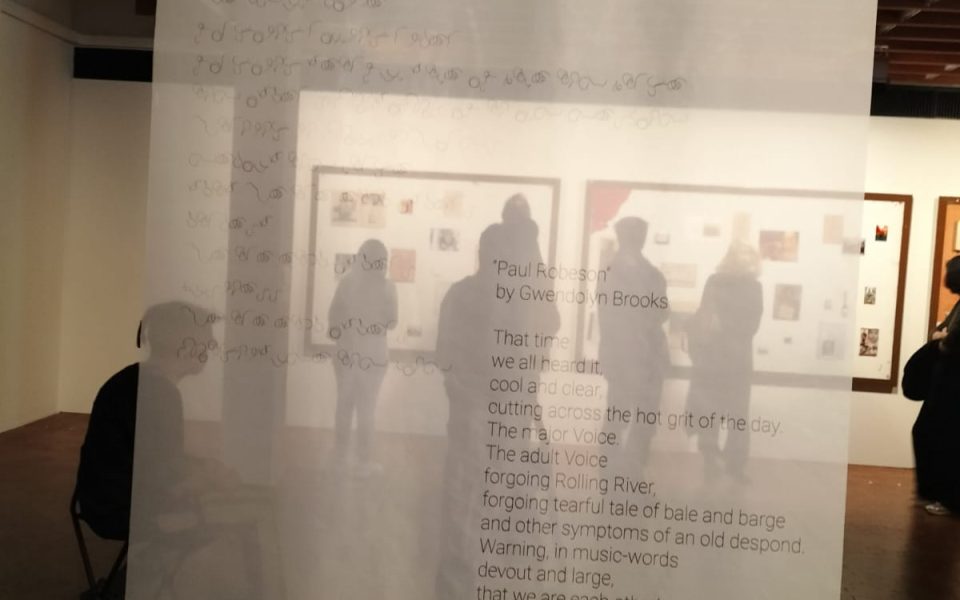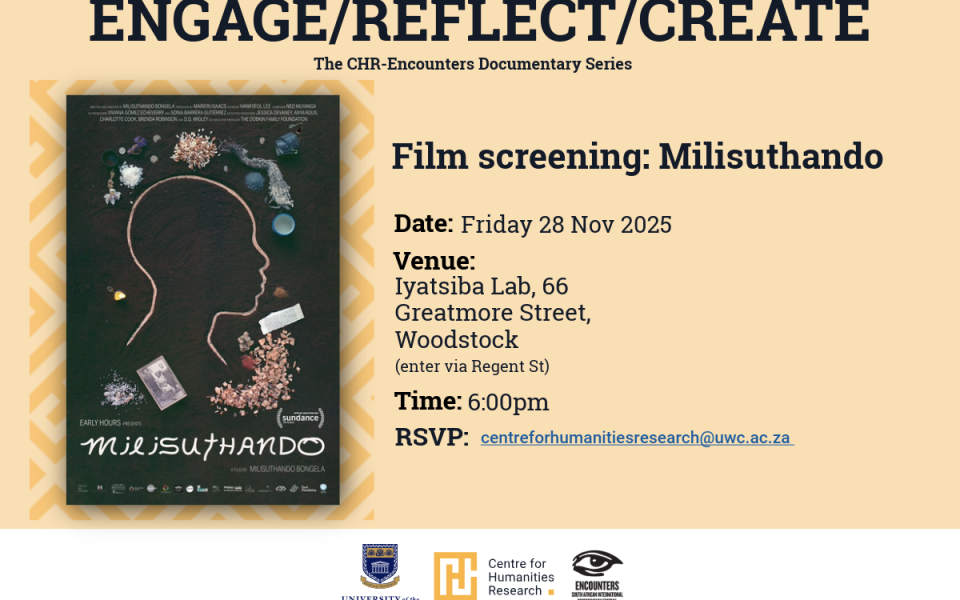Usakos – Photographs Beyond Ruins: The Old Location Albums

Namibian exhibition on photography and forced removal now opens at the District Six Museum
Usakos – Photographs Beyond Ruins: The Old Location Albums, 1920s to 1960s is an exhibition which centres on three private photographic collections owned by four female residents of the small town in central Namibia called Usakos.
 The exhibition now comes to Cape Town, and will open on Tuesday, 16 February at the District 6 Museum, followed by a walk-about and panel discussion on Saturday, 20th February (The politics, culture and pedagogy of representation) and closed with the launch of a photo and video blog on Saturday, 12th March titled: Share your story with a ‘born free’!
The exhibition now comes to Cape Town, and will open on Tuesday, 16 February at the District 6 Museum, followed by a walk-about and panel discussion on Saturday, 20th February (The politics, culture and pedagogy of representation) and closed with the launch of a photo and video blog on Saturday, 12th March titled: Share your story with a ‘born free’!
Usakos, a railway town
Usakos developed as one of the main hubs of first the German colonial and later the South African railway system, and it´s urban morphology was marked, from its early beginnings, by the policies of segregation and apartheid urban planning. The exhibition highlights a particularly traumatic moment in the town´s history, when in the early 1960s the apartheid administration began to remove African residents out of what was then called the old location into newly built townships that were geographically removed from those parts of the town henceforth reserved for “whites”.
The collectors and the collections
The photographic collections kept by the four women lay out the physical and social landscapes of the old location. They range from studio photography, images of particular location sites and buildings, photographs of mission congregations and school classes, music bands and football teams, and many portraits of men and women posing in front of the camera. Most images were taken by local or itinerant African photographers, and they evidence a vibrant aesthetic and visual culture in a cosmopolitan environment that made a stand against the containments and constrictions imposed by the politics of race.
The four women and their photographic archives are part of a trans-generational network and practice of collecting and curating. Since their lives and those of their fellow residents have been deeply marked by the experience of forced removal, and concurrently by economic decay and socio-cultural disruption, their collections have become part of diverse discourses and practices of commemoration and memorialisation.
The women´s care for the photographs, the ways in which they have, for several decades, placed them in albums, displayed them in living rooms, shared them in conversations with family, friends and acquaintances, and stored them in handbags and boxes, is an expression of how these women´s small but continuous daily aesthetic acts powerfully countered the ruination of their living environments. This is why the collections transcend the concern to recover the past alone and likewise describe an ongoing reflection of the present and invite an opening towards the future. The Usakos photographic collections then constitute forms and practices of collective mobilisation – of memory and experience, of vision and imaginary the articulated, albeit perhaps, in a more silent, submerged tone.
Paul Grendon
The resonances of the old location photographic collections in the past, present and future are taken up in the exhibition through the work of photographer Paul Grendon. Grendon´s camera follows the traces and layers of Usakos´ experience of colonialism and apartheid that remain visible in the physical and social landscape of the town: it exposes ruins of the old location houses, maps out a decaying railway infrastructure, but also explores the many ways in which residents of Usakos have and continue to relate to their environment and turn spaces of ruination into places of belonging.
The Exhibition Catalogue & Content
The exhibition catalogue includes an essay on photography and an essay on Usakos’ urban history, three image sections including black & white sections introducing the women collectors and their collections of historical photographs, and one section with colour photographs by Paul Grendon.
The exhibition consists of mobile panels on which are printed black & white photographs selected from the women’s collections and colour photographs by Paul Grendon. Additionally there are information panels and two large maps. The mobile exhibition is a newly produced version of two almost identical versions of the exhibition produced for Namibia and Overseas.
Notable to the process is the substantial involvement of students in the exhibitions in Usakos and in Basel. Based on collaboration between the University of Basel and the University of Namibia, the students of both universities participated in the mounting of the exhibition in Usakos (and also worked on common oral history projects) and again students of both universities mounted the exhibition in Basel together.
USAKOS
The opening of the first exhibition was Usakos, in the Usakos municipality building on 27 June 2015. The opening event was planned by the Usakos Municipality in collaboration with the Museums Association of Namibia. The exhibition will permanently remain in Usakos and integrated in the future local museum.
EUROPE & AMERICA
The first launch of the second exhibition, produced for Europe and America, was in Paris at Sorbonne University on 7 July 2015. The exhibition was scheduled to be shown during the European Conference of African Studies (Paris 8-10 July). Following Paris, it was shown at the Basler Afrika Bibliographien in Basel (28 August 2015), and the University of Bielefeld (7 November 2015). Further confirmed venues are the Regis West Gallery, Minneapolis (5 April 2016) and the Brunei Gallery, London (July 2017).
SOUTHERN AFRICA
A third version will be launched at the District Six Museum in Cape Town in February 2016, after which the exhibition is scheduled to go to the University of the Western Cape also in Cape Town, followed by the University of Fort Hare in East London, and the Witwatersrand University in Johannesburg. Eventually the exhibition will be handed over to the Museums Association of Namibia for further use in the country.
The exhibition is curated by Paul Grendon, Giorgio Miescher, Lorena Rizzo, and Tina Smith
Project Partners & Funders
Carl Schlettwein Stiftung Basel
Centre for African Studies, University of Basel
Freiwillige Akademische Gesellschaft BS
Max Geldner Stiftung Basel
Municipality of Usakos
Museums Association of Namibia
Stiftung Mercator Schweiz





